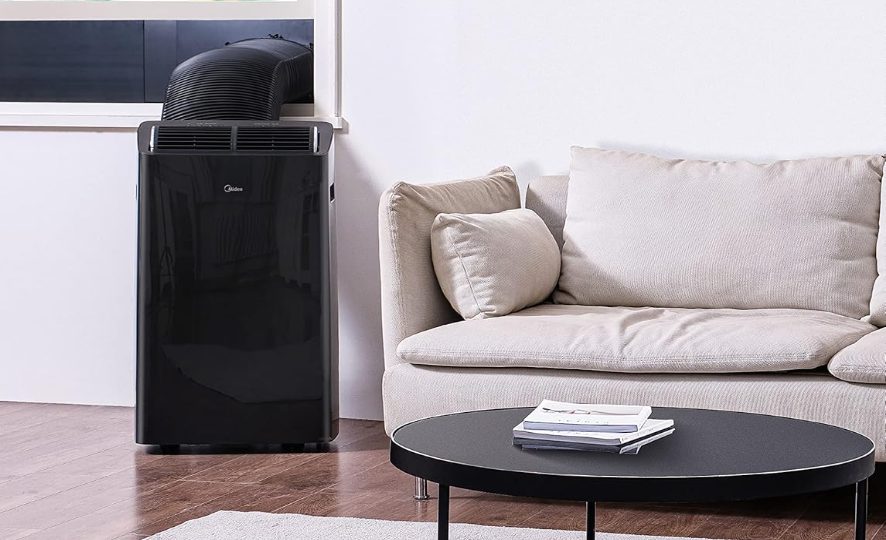
Best self-evaporating portable air conditioning units provide adaptable cooling that doesn’t require frequent emptying of condensate water because they use self-evaporating technology.
Here we spotlight the best choices in 2025:
#1 Midea Duo Smart Inverter Portable Air Conditioner
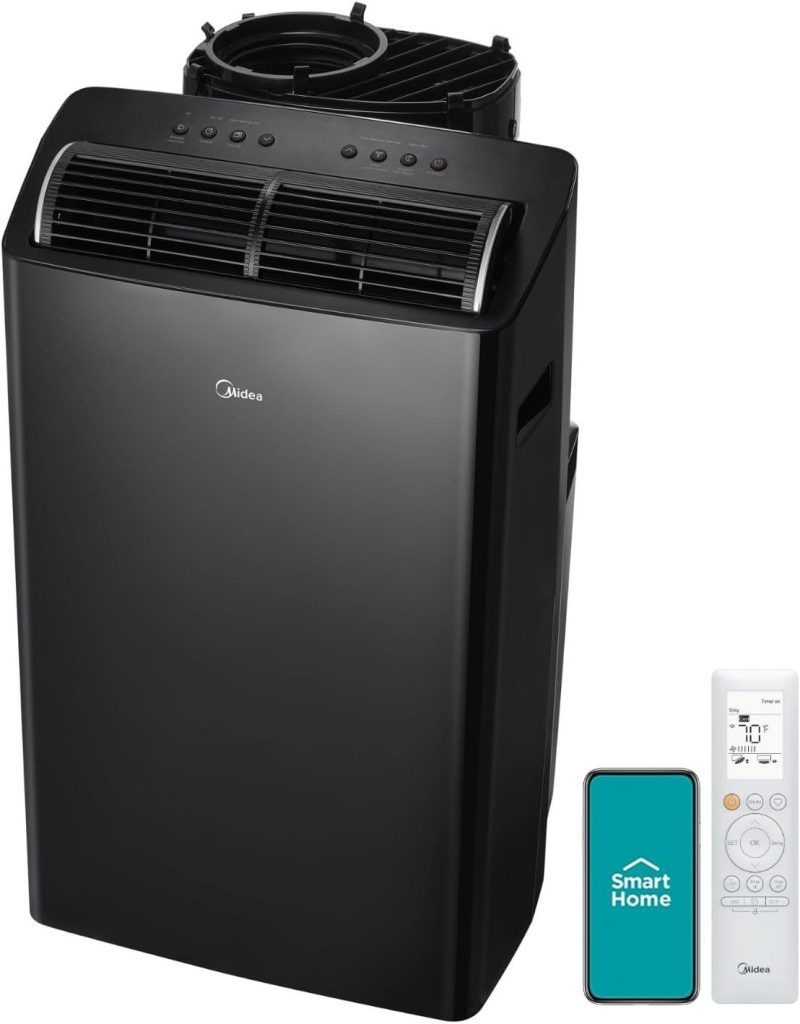
The Midea Duo is a robust portable air conditioning unit with a cooling capacity of 14,000 BTUs.
It has a unique design of two hoses in one, which makes it cool quicker and more effectively. In recent tests, it was also rated as one of the quietest and most powerful units, operating with the kind of gentle hum that’s ideal for bedrooms. Its inverter compressor also enables it to start and stop smoothly, i.e. it increases to full cooling capacity and decreases to very low power, not to higher speeds as with most other units, so it saves energy and keeps steady temperatures as it operates.
The features are so user-friendly that it is easy to assume they could be used in a similar way even if the tech was a bit less smart.
The app is well-designed, and it is a delight to control the Midea by voice through either Alexa or Google.
The Duo has a hose-in-hose structure for its intake and exhaust that keeps those two streams of air separate, which is crucial for efficiency. This structure also means the Duo can be mounted in a window or used in a space where air can be vented in a more DIY manner.
#2 Whynter ARC-14S Dual Hose Portable Air Conditioner

The dual-hose portable air conditioner, Whynter ARC-14S, is a strong performer, with one cooling possibility—14,000 BTU (9,500 BTU SACC)—for spaces up to about 500 sq. ft. It has an outside air intake, so it pulls in cool air from outside, denies the warm air access to any other room, and exhausts it back outside. It has no problem working in a space with an outside access point.
This model from Whynter has a patented function that expels condensate in nearly all conditions. That means you seldom need to empty any water – the unit constantly sends moisture out the exhaust.
For those who live in humid areas and require serious drying power, the ARC-14S has a fan-only mode; you can also run it as a massive dehumidifier (removing 71 pints a day). Despite its might, the ARC-14S isn’t obnoxiously loud. At its lowest of three settings, the most comparable sound is that of a running dishwasher (which hangs around 51 decibels). The sound might be comforting to some who think their machine has to work hard to churn out cool air.
A comprehensive window kit is included, which is compatible with the majority of window types; a remote control is also part of the package.
A dual filter system (pre-filter and activated carbon filter) is washabe and serves to “up” the indoor air quality. If you live in a space that really needs to be cooled down and you don’t want to be bothered with maintenance, the Whynter ARC-14S is a choice that tends not to disappoint.
#3 BLACK+DECKER 14,000 BTU Portable Air Conditioner

BLACK+DECKER’s 14,000 BTU portable air conditioner is a best-selling model that cools large rooms (they claim up to 600-700 sq. ft.) reliably.
It cools, it dehumidifies, and it serves as a fan, functioning in three capacities. Weighing in at about 62 lbs, it’s very easy to move and portable in the real sense of the word. Unlike many of its competitors, this unit rolls easily on its casters, and Black+Decker has included side handles in the design framework for easy lifting.
This A/C is very simply designed, and it functions very straightforwardly: the top-mounted, digital control panel and the included remote (which has a built-in thermostat sensor) make it easy to set your desired temperature. The 62 lb. weight includes the refrigerant, the functional components, and the plastic housing, which together form a very solid base. And no, there is no Frigidaire, Kenmore, or Whynter-like flimsy construction here; this portable A/C has very decent build quality.
A main characteristic is its auto water evaporation system, which means in cooling mode, the condensate evaporates and is expelled through the exhaust, eliminating the need for a drip pan. It offers both a timer and a sleep mode; the latter gradually adjusts the temperature to keep you comfortable through the night while saving energy.
Noise levels are around 52 dB at low fan speed, so it won’t overpower your conversations or TV. Overall, the BLACK+DECKER delivers solid cooling performance and hassle-free operation. That’s impressive because the low-low-low price tends to suggest otherwise.
#4 Honeywell 14,000 BTU Portable Air Conditioner

The Honeywell 14,000 BTU portable air conditioner is a high-capacity, rugged unit that well serves spaces like big rooms, apartments, and offices. It has a dual filtration system that helps keep the AC (both the indoor and outdoor units) well-maintained.
It’s capable of cooling spaces of up to about 700 sq. ft. and puts out a lot of cold air. If you’re in a very humid climate, the do-it-yourself install guide suggests that you also hook up a drain to handle the excess condensate that this beast makes.
This Honeywell portable AC has an impressive safety and reliability record. The compressor and motor have thermal overload protection — extra safeguards to keep things from getting too hot or too cold, and another good reason to love this unit. But let’s just get to the nuts and bolts here: using the Honeywell is about as easy as using any AC out there. It’s got a digital thermostat, feather-touch controls, and a full-function remote. If you thought the last unit was a dehumidifier, wait until you see this one. The Honeywell dehumidifies as it cools — and it does both pretty well. In the same price range, the Honeywell is 3 pints more per day capable than its nearest competitor (50+) and seems to have the edge when it comes to raw capacity.
This unit appears to be built for cool customers and is a highly portable device despite its size.
#5 Dreo 12,000 BTU Smart Portable Air Conditioner
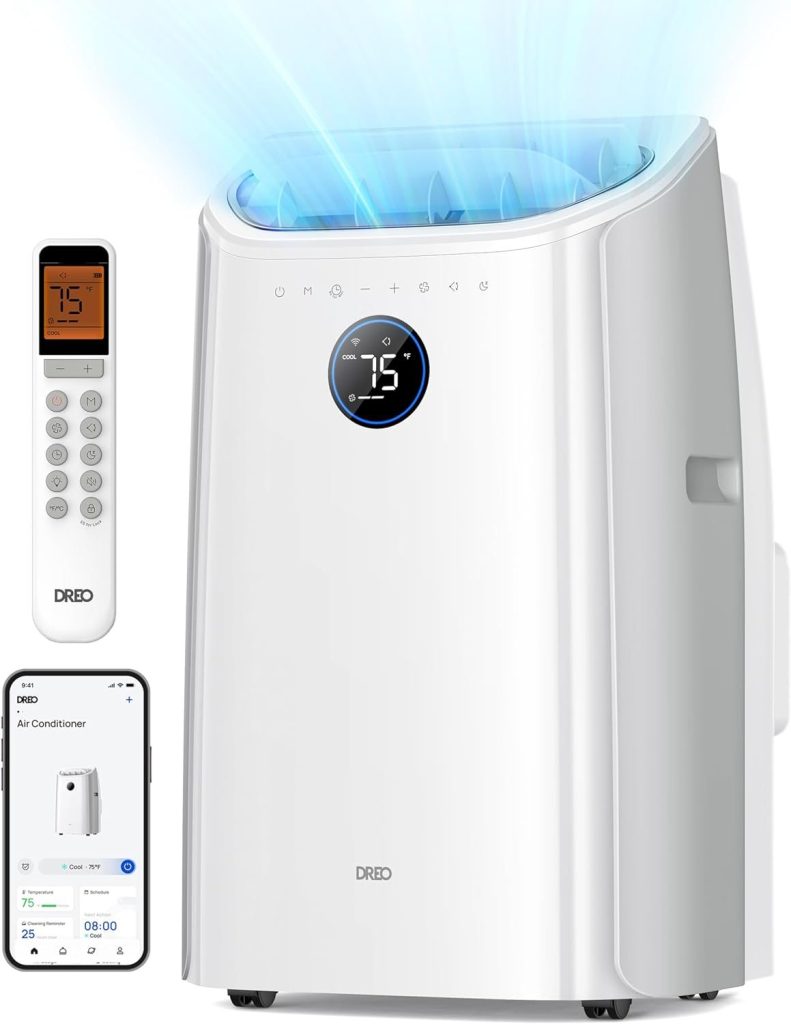
With smart integration, the Dreo AC can connect via Wi-Fi so that you can control it through a mobile app or even with your voice.
This unit is as powerful as it can get when it comes to performance. The Dreo inverter air conditioner blows cold air up to 16 feet (the cooling power is 12,000 BTU, which is suitable to small to medium rooms, and Dreo states that the air conditioner can serve up to 650 square feet). It has three settings cool, dry, fan and a user friendly customizable sleep mode.
The Dreo 12,000 BTU Smart Portable AC brings modern convenience and efficiency to smaller spaces (up to ~350 sq. ft.). It has an “industry-first” drainage-free system, so you don’t have to empty it during cooling.
The unit’s patented auto-drain technology continuously sends condensate to the condenser to evaporate, so as long as the space isn’t super humid (about 85% humidity or lower), you can set it and forget it, which is a major feature in the convenience department.
In addition, Dreo’s noise-isolation design keeps the sound to just 46 dB on its lowest setting – very quiet, perfect for bedrooms or home offices.
#6 SereneLife 10,000 BTU Portable Air Conditioner
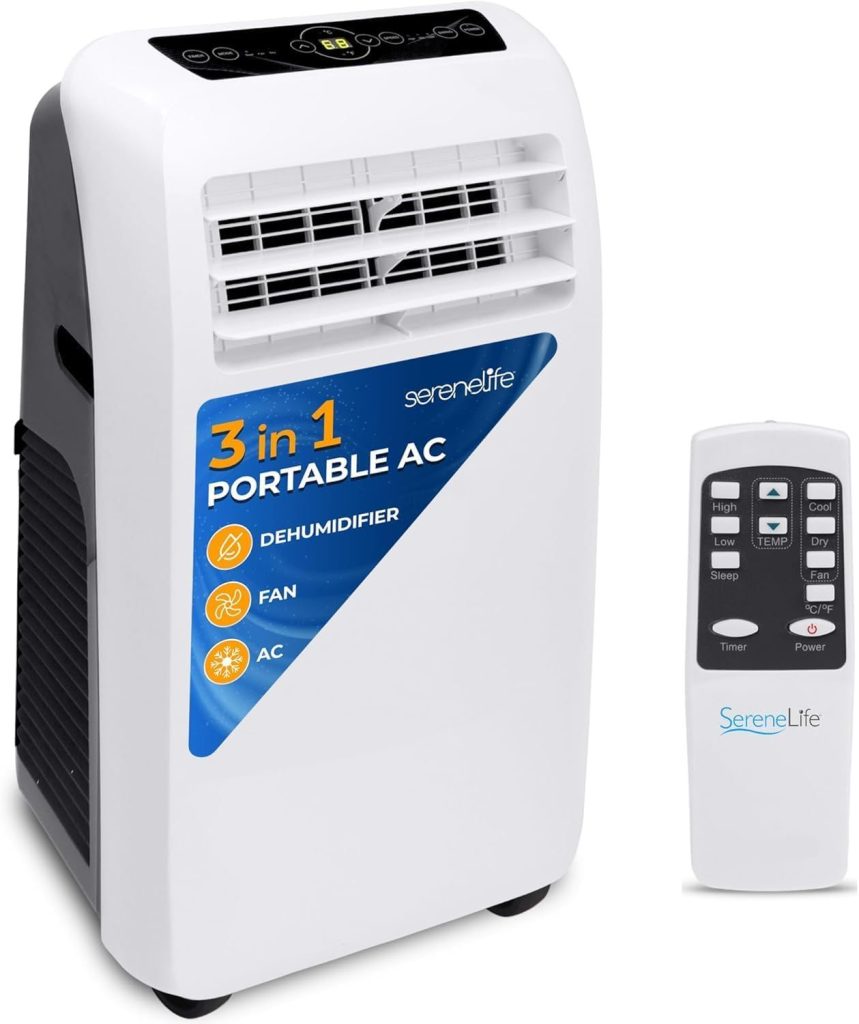
SereneLife has a portable air conditioner of 10,000 BTU that is small and flexible, which means that it can only be used in a room of approximately 400-450 sq. ft.
It is light in construction and the base has rolling caster wheels, which makes the unit easy to move; but even without the movement, the air conditioning unit can swing to cool the vast area around where it was installed.
This SereneLife AC has a self-evaporation technology whereby most of the condensate is evaporated and released through the exhaust, and you will not be peeved by the need to drain it frequently.
It has a valve drain outlet as a backup in really humid days. The in-built dehumidifier has the capacity to eradicate up to 50 pints of water per day, which leaves your space, presumably, a dry one. The installation is adored by the users as it requires only a few minutes and does not require any special tools. The unit is controlled through an easy-to-understand digital panel and a remote that the reviewer couldn’t stop praising.
It even has a Wi-Fi smart version, which you can manage using your phone or by telling your smart assistant.
#7 Shinco 10,000 BTU Portable Air Conditioner

The Shinco 10,000 BTU portable air conditioner is a budget-friendly product that can be used by cost-sensitive consumers who do not want to sacrifice the quality of cooling and dehumidifying.
It’s rated for spaces up to 300 square feet, making it a decent selection for bedrooms, dorms, or tiny apartments. This unit comes with three modes that can be used; cooling, fan and dry to support virtually any need you might have throughout the year. It’s also as portable as a wheeled air conditioner can be, thanks to integrated handles and a rolling design that, in our experience, works better than you’d assume.
The Shinco has a window venting kit which is simple to install and a remote control. When installed, you will have an easy time running it with a basic LED screen and basic controls.
It has a 24-hour programmable timer and a sleep mode which automatically changes the temperature to make it comfortable at night. It, like the others, auto-evaporates most of the condensate, that is, you will not need to drain water frequently or at all. The unit will evaporate any moisture that it gathers and blow it out. There is a drain port in case the system has to release a lot of moisture in extremely humid weather, but we never had a reason to use it and never had to depend on the unit to keep us cool in some very muggy weather.
A good feature is the auto-swing louver which blows the cool air evenly throughout the room with far greater coverage than just turning on the fan on a floor model.
#8 LG 8,000 BTU Smart Portable Air Conditioner
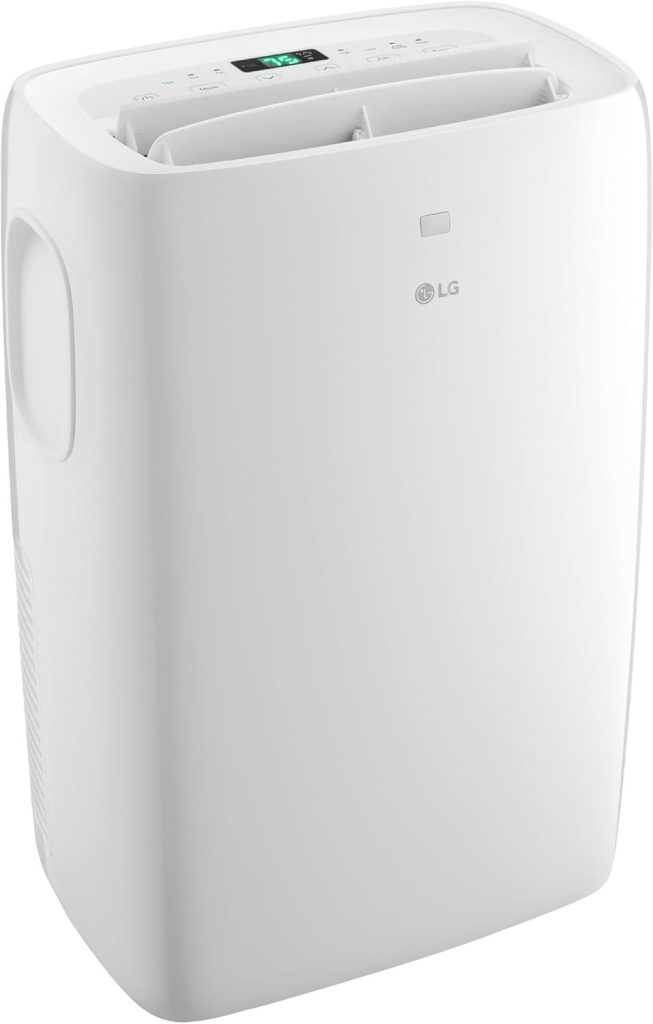
LG’s smart portable AC, with an 8,000 BTU (6,000 BTU DOE) power rating, is a superb selection for spaces as large as 250 square feet, particularly for anyone who prizes almost noiseless cooling.
With the ThinQ app on your smartphone, or by simple voice commands, you can switch the unit on and off, adjust the desired temperature, or switch between the four cooling modes. The unit does come with a standard LCD remote control if you’d rather use that.
The LG portable air conditioner is characterized by a fairly quiet functioning and effective work. It was also discovered to be less noisy than most of its competitors in laboratory tests and yet it produced very cold air output. It can work at the low fan speed of approximately the mid-40 dB range, so it will not interrupt your sleep or work.
The unit has three modes, cooling, fan-only, and dry (dehumidify) to deal with any climate conditions that face you. It is an automatic self-evaporating unit like other self-evaporating units, and therefore, there is no need to empty water regularly.
It is also easy to pull it up to a window as part of the installation, which is easy to do with its handles. And the caster wheels make the relocation easy.
Buying Guide: Choosing the Best Self-Evaporating Portable AC
When looking for a portable air conditioner, it is crucial to comprehend the main elements that influence how well the unit works and how easy it is to use. This is a thorough primer designed to aid in making a well-considered selection:
Cooling Capacity (BTU Rating)
British Thermal Units (BTUs) are how we measure an air conditioner’s cooling power. The more BTUs, the bigger the space you can cool. Two numbers are usually given for portable ACs—an ASHRAE rating and a DOE SACC rating.
The SACC rating is often much lower, and it represents the unit under real-world conditions. For instance, a unit might have a 14,000 BTU ASHRAE rating but only a 10,000 BTU SACC. When you match either number to an average room size, the unit would basically fluctuate between the two conditions it was rated under. So, BTU output is important.
- 8,000 BTU (5,000–6,000 SACC) – Cools small rooms up to 200-300 sq. ft.
- 10,000 BTU (6,500–7,000 SACC) – Cools medium rooms around 300-450 sq. ft.
- 12,000 BTU (8,000–9,000 SACC) – Cools larger rooms 400-550 sq. ft.
- 14,000 BTU (10,000+ SACC) – Cools big areas 500-700 sq. ft.
It is better to be slightly on the large size with an AC unit than the small size. A small AC will work far too hard to cool the room and will run continuously, while a larger AC may cool quickly but not as effectively dehumidify the space.
Single Hose vs. Dual Hose
Hose type significantly impacts a portable AC’s efficiency.
A single-hose air conditioning unit pulls air from the room in which it is located, cools it, and then returns that air to the room. It accomplishes this by doing three things:
1. It pulls room air in to cool its condenser.
2. It pushes that hot air outside through one hose.
3. It creates a slight negative pressure that tries to pull outside air (which is presumably warmer than the inside air) into the now-cooled room.
A dual-hose AC has two separate hoses: one draws in outside air to cool the condenser; the other expels hot exhaust air. This means it avoids pulling conditioned air out of your room, which makes cooling more efficient and faster.
Dual-hose models (like the Whynter ARC-14S and Midea Duo) are ideal for larger areas or very hot environments since they can cool without fighting against infiltration of warm air. They often can cool a space about 10-15% quicker than equivalent single-hose units.
On the downside, dual-hose ACs tend to be heavier and sometimes a bit louder due to the additional airflow. They also have a more involved setup since they have two hoses to connect to the window kit.
If top priorities are efficiency and cooling speed, or if a large area needs cooling, then a dual-hose design is worth considering. For most users, however, a good single-hose AC will adequately cool the intended space. All of the units listed use auto-evaporation, so drain needs—regardless of hose type—are minimal.
Noise Level
Fans and compressors are noisy and portable air conditioners have them. The levels of noise are normally measured in decibels; the lesser the number, the quieter the unit.
To give an example, 50 dB (approximately as quiet as a portable air conditioner can get) is roughly as loud as a quiet conversation (or moderate rain). If your portable air conditioner is putting out 52 dB or less, it probably qualifies as “quiet” (at least by my standards).
Some of our favorites actually make the point of whisper-quiet operation. The Dreo, as an example, is very silent at 46 dB on the lowest setting, which is very quiet compared to an AC. The dual-inverter technology of LG also appears to be doing its part in ensuring that noise levels are minimized (it can handle about 45 dB in quiet mode, which is nearly too quiet to believe). Whynter dual-hose models may sound a little louder on high fan (about 57 dB at max), but they can still make things relatively quiet (and cool). Black+Decker and SereneLife models are in the middle of the road, so to speak, about 55-57 dB on high and certainly not as loud on low.
Smart Features and Controls
The modern portable ACs have more features that increase convenience. At least, the units are provided with the basic controls including a digital thermostat, remote control, and timer. More luxurious models may provide you with a reason to smile – smart connectivity (Wi-Fi). Imagine this: both the Midea Duo and Dreo are Wi-Fi enabled, which means that you can use the respective apps to have some fun and play with, well, cooling your apartment before going back to it. Are you the type that can hardly operate until every room is a cool 60 degrees?) You may also switch the modes and monitor the temperature without leaving the bed. And these two specific units also grant app control in a variety of other functions.
To use the unit in a basic, nearly hands-free manner, seek auto mode (the unit chooses the fan speed depending on temperature) or smart home connectivity. That said, if you just want to cool your room, a Wi-Fi connection isn’t necessary. Simple functions such as a 24-hour programmable timer, oscillating louvers, and multiple fan speeds may be the difference between a unit with and without smart tech. Most portable air conditioners also come with a remote; unlike the thermostat that lives inside the unit, the remote’s or your body’s temperature isn’t factored into the air conditioner’s equation. Nevertheless, not all remotes talk to each other.
Don’t dismiss maintenance features:
a filter clean alert is great (not all portables have it — Shinco’s model has no “check filter” light, but you should clean its filter periodically). Filters are washable and can be easily rinsed out once a month to maintain a high flow of air. Lastly, the general user interface, a big LED screen and easy controls are more readable and convenient. If you plan to run the AC in a dark bedroom, a display that can dim or go completely dark (so bright LEDs don’t interfere with your sleep) is a nice touch.
Energy Efficiency
Generally, portable air conditioners are not as efficient as window units.
However, some models make great steps to energy saving. The EER (Energy Efficiency Ratio) or the combined CEER/SEER is one of the measures of efficiency that is used to judge efficiency. The more the number, the more efficient. As an example, a portable AC has good EER of 10. Inverter-driven units (like the Midea Duo and LG) tend to use less electricity, not because they’re designed to save energy, but because they operate much more efficiently than non-inverter units. They have more constant room temperatures. The fact that they are less noisy is an added advantage. Both of my Midea and LG inverter ACs consumed about 4-5 amps at my test temperature of approximately 76 degrees, so they were consuming about 500-600 watts.


